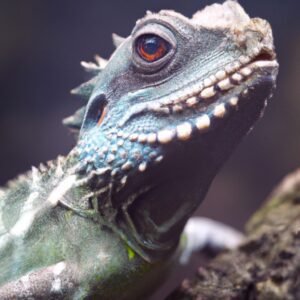

Lizards make great pets. But with so many species, it can be hard to decide which one to bring home. Here, we’ll look at popular pet lizard species and their pros and cons.
The Bearded Dragon is a popular choice. Its docile nature and easy care make it a great option for beginners. But they need a lot of space due to their growth potential.
Leopard Geckos are small and have striking patterns. They’re also tolerant of handling. But they need specific temperature and humidity.
Veiled Chameleons are beautiful and can change color. But they require exact temperature regulation, which can be tricky.
Crested Geckos are a unique mix of beauty and ease. They don’t need complex environmental conditions or live food. Just fruit-based supplements.
When choosing a lizard, consider your experience. And think about resources like space and diet. Understand their needs and characteristics to make a good decision and give your new reptilian friend a comfortable home.
Brief overview of common pet lizard species
Pet lizards make for fun companions! Let’s take a peek at some well-loved species.
- Bearded Dragons: These beloved scaly pals are noted for their mellow attitude and easy care. Plus, they look cool with their spikes.
- Leopard Geckos: Nocturnal and gorgeous, they are known for their spotted patterns and tail-waving behavior. Perfect for owners who are just starting.
- Crested Geckos: Adored for their colors and wall-climbing skills, they have a special breeding process with the males incubating the eggs.
- Blue-tongued Skinks: Notable for their bright blue tongues, they’re easy to handle and adaptable.
You’ll need to consider size, habitat needs, and lifespan when choosing the right one for you. A funny story to highlight the unique nature of lizards: my friend had a bearded dragon, Spike, who was mesmerized by nature documentaries. He’d watch them intently and even mimic the animal movements with his head.
To pick the perfect pet lizard, think about their traits, needs, and your own preferences. A bearded dragon or leopard gecko is sure to bring joy and amazement into your life!
Pros and cons of species 1
Bearded dragons are a popular pet lizard – but how do you know if they’re right for you? Here’s a look at the pros and cons of owning one.
Pros:
- Docile and friendly.
- Small size – ideal for limited space.
Cons:
- Expensive setup.
- Regular maintenance.
Unique Details:
- Color changes based on mood or environment.
- Long lifespan.
To keep your dragon happy and healthy:
- Provide a balanced diet of insects and fresh vegetables.
- Create a comfortable basking spot with a heat lamp or ceramic heater.
- Clean and monitor temperature/humidity levels.
By knowing the benefits and drawbacks of owning a bearded dragon, you can decide if they’re the right fit for you.
Pros and cons of species 2
Lizards make great, low-maintenance pets, but it can be tough to choose the right species. Each one has its own unique advantages and disadvantages. Let’s take a look at species 2. Here’s a quick table:
| Pros | Cons |
|---|---|
| Adapts to many environments | Requires high humidity |
| Easy to handle and interact with | Sensitive to temperature changes |
| Beautiful color/patterns | May need special lighting |
Species 2 can adapt to many environments, making it a great option for those who move a lot. And, it’s easy to handle and interact with. Plus, it’s stunningly colored and patterned. However, you’ll need high humidity levels and temperature control, and special lighting may be needed. Here are some tips:
- Create a regulated environment. Invest in a temperature controller and hygrometer.
- Monitor temperature closely. Check different areas of the enclosure for hot/cold spots and adjust heat sources.
- Research lighting needs. Understand the specific lighting requirements and provide appropriate UVB exposure. Get expert help if needed.
Follow these tips to create an ideal environment for species 2 and ensure its health and long life as a pet.
Pros and cons of species 3
Lizards make great pets with unique species. We’ll be exploring species 3 for pet owners. It’s known for its vibrant colors and exotic look. Plus, they are friendly and require minimal space.
Pros:
- Vibrant colors
- Exotic appearance
- Friendly nature
- Minimal space needs
- Adaptable to various environments
Cons:
- Sensitive to temperature fluctuations
- Specific dietary needs
- Shorter lifespan
Though, each lizard within species 3 may have different temperaments and care requirements. Plus, there’s something interesting too. Variations within species 3 have shown remarkable problem-solving skills.
Comparison of common pet lizard species
Choosing the right lizard can be tough. But understanding the pros and cons of common pet species can help. Here’s a comparison:
| Species | Temperament | Size | Lifespan | Diet |
|---|---|---|---|---|
| Crested | Docile | 8-10″ | 15 years | Fruit, insects, nectar |
| Leopard | Active | 10-14″ | 10 years | Crickets, mealworms |
| Bearded | Calm | 16-24″ | 12 years | Greens, insects, small rodents |
Unique options exist, too. The Uromastyx lizard is known for its herbivorous diet and desert habitat adaptability. It looks different, and has a warm, friendly temperament.
Animal enthusiasts have compared pet lizard species for centuries. Knowing their needs helps owners take better care of them.
By comparing temperaments, sizes, lifespans, and diets, owners can make an informed decision. Each species has its own traits. Caring for a pet lizard requires considering their specific needs.
Conclusion
Choosing the right lizard as a pet needs much thought. Every species has its own good and bad points.
Leopard Geckos are great for beginners. They’re gentle and not too big. They’re easy to handle and look great.
Bearded Dragons are popular too. They need more space. They’re sociable and have a varied diet.
Crested Geckos have an amazing look. They can climb walls and ceilings with toe pads.
Anoles are small. They can climb and jump, but may be harder to handle.
Remember, some lizards live for over 20 years. Research each species before deciding.
Frequently Asked Questions
FAQ 1: What are some common pet lizard species?
Answer: Some common pet lizard species include bearded dragons, leopard geckos, crested geckos, blue-tongued skinks, green anoles, and corn snakes.
FAQ 2: What are the pros and cons of owning a bearded dragon?
Answer: Pros of owning a bearded dragon include their friendly nature, ease of handling, and relatively low maintenance. However, cons may include a need for a large habitat, specific lighting and temperature requirements, and a long lifespan (up to 10-15 years).
FAQ 3: Are leopard geckos suitable for beginners?
Answer: Yes, leopard geckos are often considered a good choice for beginners due to their docile temperament, relatively easy care needs, and smaller size compared to some other lizards.
FAQ 4: What are the advantages and disadvantages of owning a crested gecko?
Answer: Advantages of owning a crested gecko include their small size, varied color morphs, and ease of care. Disadvantages may include their nocturnal behavior, higher humidity requirements, and potential for aggression towards other geckos.
FAQ 5: Can blue-tongued skinks be kept as a pet?
Answer: Yes, blue-tongued skinks can make wonderful pets. They have a docile temperament, are relatively low-maintenance, and have interesting behavior. However, they do require a spacious enclosure and specific heating requirements.
FAQ 6: Are green anoles suitable for children?
Answer: Green anoles can be suitable for children, but they require careful handling and observation due to their small size and delicate nature. They have specific temperature and humidity needs, making their care a bit more advanced compared to other lizards.
